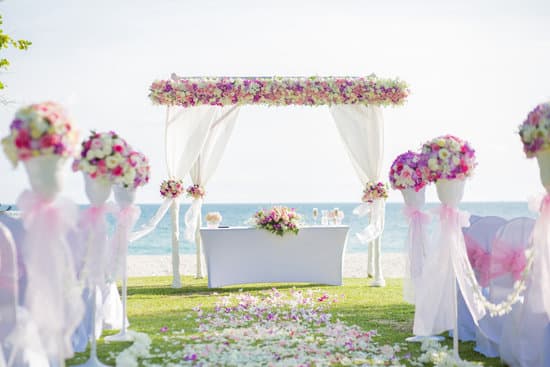Planning a wedding involves making countless decisions, from selecting the perfect venue to deciding on the menu and decorations. One critical aspect that may often be overlooked is the wording and addressing of wedding invitations, particularly when it comes to inclusivity for LGBTQ+ couples. Understanding how to address gay couples on wedding invitations is not only a matter of etiquette but also a reflection of respect and acknowledgement of diverse relationships.
In this section, we will explore the importance of inclusivity in modern wedding etiquette and discuss the historical exclusion of LGBTQ+ couples in traditional wedding invitations. By delving into this topic, we aim to provide readers with valuable insights into understanding the significance of addressing gay couples correctly on their wedding invitations.
In addition, we will also provide specific examples of how to address gay couples on wedding invitations, as well as explain the etiquette behind using correct titles and addressing both partners equally. By doing so, we hope to offer practical guidance for couples who wish to ensure that their wedding invitations are inclusive and respectful of all types of relationships.
Stay tuned for valuable information on embracing diversity in wedding invitation design, navigating family dynamics when addressing LGBTQ+ couples, and creating LGBTQ+ friendly invitation wording.
Addressing Gay Couples on Wedding Invitations
Addressing LGBTQ+ couples on wedding invitations is an essential aspect of modern wedding etiquette. As society becomes more inclusive and diverse, it is crucial to understand how to properly address gay couples on wedding invitations in a respectful and considerate manner. This section will provide specific examples and etiquette guidelines for addressing LGBTQ+ couples on wedding invitations, ensuring that all couples feel acknowledged and honored on their special day.
When addressing a gay couple on a wedding invitation, it is important to use the correct titles and address both partners equally. For example, if one partner holds a professional or honorary title, such as “Dr.” or “Honorable,” it should be included before their name. Additionally, both partners’ names should be listed on the invitation in the same manner as heterosexual couples, without any distinction or differentiation.
An example of addressing a gay couple on a wedding invitation could be:
- Mr. John Smith and Mr. Michael Johnson
- Dr. Alex Williams and Mr. David Lee
The key etiquette behind addressing gay couples on wedding invitations lies in treating them with the same respect and consideration as any other couple. Using correct titles, listing both partners’ names equally, and avoiding any assumptions about gender roles are all important aspects of creating inclusive and respectful wedding invitations.
It’s essential to ensure that the language used on the wedding invitation is gender-neutral and inclusive. By choosing words that reflect inclusivity and respect for LGBTQ+ relationships, couples can create an inviting atmosphere for all guests. Creating invitations that embrace diversity through design, language, and proper addressing demonstrates a commitment to inclusivity and sets a positive tone for the celebration.
The Power of Language
When it comes to creating wedding invitations that are inclusive of LGBTQ+ couples, language plays a crucial role in ensuring that all partners feel equally respected and represented. The use of proper titles and gender-neutral language can make a significant impact on the inclusivity of wedding invitations.
Impact of Language on Inclusivity
The language used in wedding invitations has the power to either include or exclude LGBTQ+ couples. Traditional wedding invitation wording often assumes a heterosexual partnership, which can be off-putting for same-sex couples. It is important to recognize the impact of language on inclusivity and choose words that are welcoming and respectful to all individuals, regardless of their sexual orientation or gender identity.
Suggestions for Gender-Neutral Language
Additionally, when addressing the couple directly, opt for inclusive terms like “Partner 1” and “Partner 2” or simply use their first names without specifying gender-specific titles. By incorporating gender-neutral language, you can create an invitation that is welcoming to all guests, regardless of their relationship dynamics.
Inclusive Terms for Invitations
These terms not only acknowledge the presence of LGBTQ+ couples but also convey a message of acceptance and celebration of love in all its forms. When choosing words for inclusive invitations, it’s essential to prioritize inclusivity and respect for all guests attending the wedding.
Understanding Different Types of Relationships
Understanding LGBTQ+ Relationship Dynamics
When it comes to addressing LGBTQ+ couples on wedding invitations, it’s essential to understand the diverse range of relationship dynamics within the community. From same-sex couples to non-binary individuals and polyamorous partnerships, there are various types of relationships that may require different approaches when it comes to addressing wedding invitations. Understanding and respecting these dynamics is crucial for creating inclusive and respectful invitations.
Properly Addressing Different Types of LGBTQ+ Couples
Addressing LGBTQ+ couples on wedding invitations requires careful consideration of individual preferences and identities. For same-sex couples, it’s important to avoid assuming traditional gender roles when addressing the invitation. Using inclusive language and titles that honor both partners equally is key. For non-binary individuals or those in polyamorous relationships, addressing the invitation respectfully means acknowledging their chosen titles and preferred terms of address.
Respecting Diverse Partnership Structures
Each LGBTQ+ couple has its own unique partnership structure, and it’s vital to respect and honor these differences when creating wedding invitations. Whether it’s a long-term monogamous relationship, a newly formed partnership, or a polyamorous arrangement, understanding the nature of the couple’s relationship can help in choosing the appropriate wording and addressing protocol for the invitation. Embracing this diversity in partnership structures showcases inclusivity and acknowledges the varied experiences within the LGBTQ+ community.
By considering the specific dynamics of different LGBTQ+ relationships and adopting an inclusive approach to addressing wedding invitations, couples can ensure that their invitations are respectful, representative, and welcoming to all guests.
Embracing Diversity in Wedding Invitation Design
When it comes to designing wedding invitations for LGBTQ+ couples, embracing diversity and inclusivity is key. The design of a wedding invitation can serve as a powerful statement of support and acceptance for all couples, regardless of sexual orientation or gender identity. Here are some ways to showcase inclusivity and diversity in the design of wedding invitations:
- Use of Inclusive Imagery: Incorporating symbols and imagery that reflect LGBTQ+ representation can be a meaningful way to show support for the community. This could include using rainbow colors, same-sex symbols, or other inclusive designs that celebrate love in all its forms.
- Gender-Neutral Color Palettes: Opting for gender-neutral color palettes can help create a more inclusive feel for wedding invitations. Choosing colors that are not traditionally associated with gender can signal an openness to all types of relationships.
- Representation in Artwork: Consider featuring diverse couples in the artwork or illustrations on the invitation. This could involve showcasing different types of relationships, including same-sex couples, in a tasteful and respectful manner.
By thoughtfully incorporating these elements into the design of wedding invitations, couples can send a clear message of inclusivity and acceptance to their guests. The power of visual representation should not be underestimated, and by carefully considering these design choices, couples can create invitations that truly celebrate love in all its beautiful forms.
Additionally, it’s important to remember that inclusive design should extend beyond just the invitation itself. It’s also essential to consider the entire suite of wedding stationery, including save-the-dates, RSVP cards, and even thank you notes. Each piece presents an opportunity to continue showcasing diversity and inclusion throughout the wedding celebration.
Navigating Family Dynamics
Addressing LGBTQ+ couples on wedding invitations can sometimes bring up complex family dynamics, especially in the context of traditional and non-traditional families. In traditional families, there may be older relatives or more conservative members who are not accustomed to seeing same-sex couples acknowledged on formal invitations. On the other hand, non-traditional families may have unique dynamics that require thoughtful consideration when addressing LGBTQ+ couples on wedding invitations.
It is important to approach these situations with sensitivity and respect. One way to navigate such family dynamics is through open communication. Couples should consider having respectful conversations with their LGBTQ+ friends and family members to ensure that their invitations are inclusive and reflective of the couple’s love and acceptance.
Additionally, it can be helpful for couples to seek advice from wedding invitation professionals who are experienced in handling diverse family dynamics. These professionals can provide valuable guidance on how to address LGBTQ+ couples on wedding invitations in a way that ensures inclusivity while also respecting varying family structures. Despite potential challenges, it is possible to create wedding invitations that celebrate love in all its forms.
| Wedding Invitation Tips | Addressing LGBTQ+ Couples |
|---|---|
| Open Communication | Sensitive Conversations |
| Professional Advice | Seeking Guidance |
Inclusive Wedding Invitation Wording
When it comes to creating wedding invitations for LGBTQ+ couples, using inclusive and respectful language is essential. This not only reflects the couple’s commitment to inclusivity but also shows respect for their guests. Here are some tips for crafting LGBTQ+ friendly wedding invitations:
Use Gender-Neutral Language
When addressing the couple on the invitation, it’s important to use gender-neutral language that includes both partners equally. For example, instead of “Mr. and Mrs.” opt for “Ms. and Ms.” or “Mx. and Mx.” This ensures that both partners are given equal recognition on the invitation.
Address Both Partners by Name
Including both partners’ names on the invitation is crucial for acknowledging their relationship as equals. Whether it’s a formal or more casual invitation, using both names clearly communicates that both individuals are involved in the event.
Consider Using Inclusive Terms
In addition to using gender-neutral language, consider using inclusive terms such as “Together with their families” or “With joy in our hearts” instead of traditional phrases that may exclude LGBTQ+ couples. These small adjustments can make a big difference in how the invitation is received by guests.
By following these tips, couples can create wedding invitations that are truly inclusive and reflective of their love and commitment to each other, while also demonstrating respect for their LGBTQ+ friends and family members who will be celebrating with them on their special day.
The Importance of Open Communication
When it comes to addressing LGBTQ+ couples on wedding invitations, the importance of open communication cannot be overstated. Engaging in respectful and thoughtful dialogue with LGBTQ+ friends and family members is crucial for ensuring that invitations are inclusive and respectful. By having these conversations, couples can gain insight into the preferences of their LGBTQ+ loved ones and make any necessary adjustments to the wording or addressing of their invitations.
One of the key aspects of open communication is being willing to listen and learn from the experiences and perspectives of LGBTQ+ individuals. This can involve asking questions about how they prefer to be addressed on wedding invitations, as well as seeking guidance on language that is both respectful and inclusive. By actively listening to their input, couples can demonstrate their commitment to creating an environment of acceptance and inclusivity for all.
In addition to engaging in open dialogue with LGBTQ+ individuals, couples may also consider seeking out resources and guides on proper wedding invitation etiquette for addressing LGBTQ+ couples. Whether it’s consulting with wedding planners experienced in inclusive ceremonies or researching reputable sources online, there are numerous resources available to help couples navigate this aspect of wedding planning with sensitivity and respect.
Ultimately, by prioritizing open communication and learning from diverse perspectives, couples can ensure that their wedding invitations reflect a genuine spirit of inclusivity and celebration for all.
Frequently Asked Questions
How Do You Address a Wedding Card to a Gay Couple?
When addressing a wedding card to a gay couple, it’s important to use both partners’ names on the envelope and inside the card. You can also use “Mr. and Mr.” or “Ms. and Ms.” before their last names.
Whose Name Goes First on a Gay Wedding Invitation?
Traditionally, the name of the person you are closer to goes first on a wedding invitation, regardless of gender or sexual orientation. However, some couples may choose to alphabetize their names instead.
How Do You Address a Letter to a Gay Couple?
When addressing a letter to a gay couple, use both partners’ names on the envelope and inside the letter. If they have different last names, simply write both full names without any additional titles like “Mr.” or “Ms.”

I have been involved in marriages for over 20 years helping couples and singles understand more about them.





